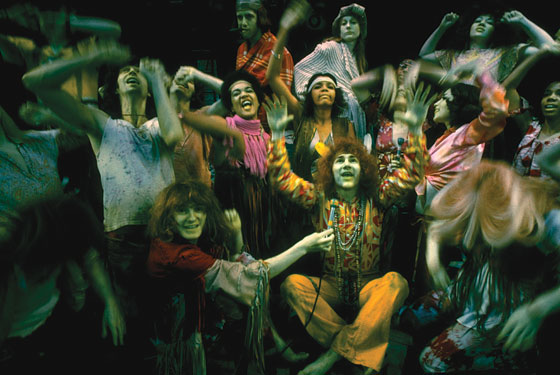 |
From Hair (1968)
(Photo: Martha Swope) |
Sometime around the first pressing of Meet the Beatles, Broadway lost its hold on America’s consciousness. This list reflects the more adventurous and productive steps taken to get it back. Driven by downtown innovation bubbling up to Broadway stages, these plays found new ways of telling stories, new stories to tell, or both. It favors homegrown work over imports (and thus omits, say, Peter Brook’s radical white-box staging of A Midsummer Night’s Dream). It also emphasizes premieres over great revivals like Jason Robards and Colleen Dewhurst in A Moon for the Misbegotten. Though some stories don’t concern New York, they are all, in the end, New York plays. The nightly give-and-take with a Manhattan crowd molded them into a different form than if they’d played one of the cities orbiting this one in the cosmology of American theater.
HAIR, 1968
A generation before Spring Awakening, composer Galt McDermot and lyricist-librettists Gerome Ragni and James Rado didn’t just prove that rock music could work on Broadway—they created a soundtrack (and name) for the Age of Aquarius. Just as important, this story of a “tribe” of Greenwich Village hippies inaugurated Joe Papp’s Public Theater—which, for all its ups and downs, has been the heart of the New York stage world ever since.
COMPANY, 1970
In George Furth’s account of an emotionally blocked bachelor’s birthday, on Boris Aronson’s Manhattan-writ-small set, Stephen Sondheim captured the isolation amid the frenzy of New York life. His first success as a serious composer-lyricist (after the comic A Funny Thing Happened on the Way to the Forum) brought new complexity and darker shadows to Broadway. Even now, other songwriters are struggling to catch up.
FRAGMENTS OF A GREEK TRILOGY, 1974
Performed mainly in foreign languages, and all around its audiences at La Mama, Andrei Serban’s staging of ancient myth schooled a generation of New York artists on how to blow up a classic. It liberated directors to stage work that’s primal, ritualized, dangerous.
A CHORUS LINE, 1975
With the radical idea of building a metashow from interviews, Michael Bennett and his writers captured the joy and ugliness of Broadway dancers’ lives. Its fifteen-year Broadway run also kept the Public solvent, thereby making it the rare show to all at once celebrate, challenge, and fund the theater culture of New York.
CHICAGO, 1975
Title aside, this musical tale of murderous vixens has always seemed a perfect fit for tabloid-happy Manhattan. Bob Fosse’s slinky genius and John Kander and Fred Ebb’s retro-ragtime score were a hit when the show premiered and again when it returned in 1996 for a run that looks more or less permanent. The film version reinvigorated the movie-musical genre.
27 WAGONS FULL OF COTTON/ A MEMORY OF TWO MONDAYS, 1976
In the Tennessee Williams one-act that began the show, she appeared as a fat southern wife; in Arthur Miller’s short play after intermission, she reappeared as a sexy New York secretary. So complete was her transformation that, according to legend, some in the audience failed to realize they were seeing the same actress—a recent drama-school graduate whom the city would soon come to revere, Meryl Streep.
AMERICAN BUFFALO, 1977
By 1977, Chicago audiences had grown accustomed to David Mamet’s profane poetry. But that year, when Robert Duvall burst onto a Broadway stage with the filthiest entrance speech ever written (“Fuckin’ Ruthie,” it begins), the world got its widest exposure yet to Mametspeak—which, frankly, sounds more like some corners of this town than Chicago anyway.
THE THREEPENNY OPERA, 1976 REVIVAL
For 40 years, Richard Foreman has ensured that no matter how smoothly gentrified this city might get, it’s still home to work that’s odd and challenging and original. The East Village maestro is also responsible for one of New York’s great downtown-uptown cross-pollinations, directing Brecht and Weill’s masterpiece on the big Lincoln Center stage—a huge, grotesque production starring the seductive Raul Julia at his best.
“AND I AM TELLING YOU I’M NOT GOING,” FROM DREAMGIRLS, 1981
According to New York myth, four minutes can make you famous. Rarely has that been truer than in the case of Jennifer Holliday, whose monumentally showstopping solo made her synonymous with Broadway diva. Jennifer Hudson did fine in the movie, but if you want to hear somebody turn the volume and the soul up to 12, find the cast album.
THE MYSTERY OF IRMA VEP, 1984
The odd, ingenious Charles Ludlam and his partner, Everett Quinton, gender-swapped their way through nearly a dozen roles while sending up cheap horror stories. Today, the 1984 comedy stands as one of the great achievements of a generation of downtown artists decimated by AIDS. Ludlam died in 1987, too soon to enjoy his play’s worldwide success. (Weird fact he’d have liked: It became the longest-running play in Brazil’s history.)

